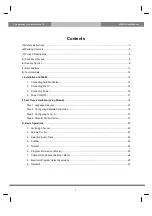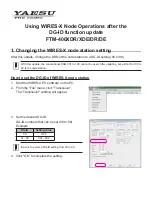
DDS VFO Construction Manual – Issue 1
Page 5
2
C
IRCUIT
D
ESCRIPTION
Integrated circuit U2 is an Analog Devices AD9834 Direct Digital Synthesis (DDS) chip and
forms the heart of the DDS VFO. A 50MHz crystal oscillator module supplies the master clock
and gives usable output frequencies up to a quarter of that value or 12.5MHz.
The DDS is controlled by a 3 wire serial data bus from microcontroller U1.The microcontroller is
an Atmel ATmega8 and runs an internal 8MHz clock which avoids the use and expense of an
external crystal.
A rotary encoder produces quadrature signals when rotated and one line is fed into the
microcontroller interrupt input and becomes the reference input. Once an interrupt is detected
the state of the other input is read and the direction determined. The rotary encoder also
incorporates a press button switch and is used for a number of functions as described later. U1
incorporates pull-up resistors for the encoder inputs so they are normally held high and
capacitors C7 and C8 filter out switch bounce.
The microcontroller has an internal analog to digital converter (ADC) which uses the 5 volt rail
as a reference. The ADC measures the incoming power supply rail via a resistive attenuator
formed with R5 and R6. The calculated value is displayed on the LCD during use. Two other
inputs, one analog (A) and the second digital (D), have been included in the PCB layout but are
not implemented in the current software release. The PCB also includes an ISP connector to
allow future software upgrades without having to remove the chip from its socket.
Most of the remaining pins of U1 are dedicated to driving the LCD in 4 bit mode. R9 sets the
backlight current and may be left out if a non-backlight LCD is used. VR1 adjusts the LCD
contrast and normally only needs to be set once at the testing stage.
The outputs from the DDS chip are current sources and the output is converted to a voltage by
the 200 ohm resistors R12 and R13. The full scale value of the current and hence the pk-pk
output voltage is set by the 5.6K ohm resistor R11. The output is passed through a simple
10MHz Butterworth low pass filter to attenuate unwanted high frequency components.
The incoming power supply is regulated to 5V by a 7805 1A regulator which mounts flat on the
PCB to act as a heatsink.
































